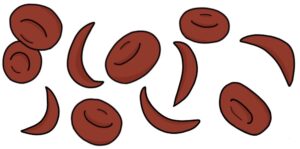Sickle cell anaemia is a genetic condition that causes sickle (crescent) shaped red blood cells.

The abnormal shape makes the red blood cells more fragile and easily destroyed, leading to haemolytic anaemia. Patients with sickle cell anaemia are prone to various sickle cell crises.
Pathophysiology
Haemoglobin is the protein in red blood cells that transports oxygen. During fetal development, at around 32-36 weeks gestation, fetal haemoglobin (HbF) production decreases, and adult haemoglobin (HbA) increases. There is a gradual transition from HbF to HbA. At birth, around half the haemoglobin is HbF, and half is HbA. By six months of age, very little HbF is produced, and red blood cells contain almost entirely HbA.
Patients with sickle-cell disease have an abnormal variant called haemoglobin S (HbS). HbS results in sickle-shaped red blood cells.
Sickle cell anaemia is an autosomal recessive condition affecting the gene for beta-globin on chromosome 11. One abnormal copy of the gene results in sickle-cell trait. Patients with sickle-cell trait are usually asymptomatic. They are carriers of the condition. Two abnormal copies result in sickle-cell disease.
Relation to Malaria
Sickle cell disease is more common in patients from areas traditionally affected by malaria, such as Africa, India, the Middle East and the Caribbean. Having one copy of the gene (sickle cell trait) reduces the severity of malaria. As a result, patients with sickle cell trait are more likely to survive malaria and pass on their genes. Therefore, there is a selective advantage to having the sickle cell gene in areas of malaria, making it more common.
Screening
Sickle cell disease is tested for on the newborn blood spot screening test at around five days of age.
Pregnant women at high risk of being carriers of the sickle cell gene are offered testing.
Complications
- Anaemia
- Increased risk of infection
- Chronic kidney disease
- Sickle cell crises
- Acute chest syndrome
- Stroke
- Avascular necrosis in large joints such as the hip
- Pulmonary hypertension
- Gallstones
- Priapism (painful and persistent penile erections)
Sickle Cell Crisis
Sickle cell crisis refers to a spectrum of acute exacerbations caused by sickle cell disease. These range from mild to life-threatening. They can occur spontaneously or triggered by dehydration, infection, stress or cold weather.
There is no specific treatment for sickle cell crisis. They are managed supportively, with:
- Low threshold for admission to hospital
- Treating infections that may have triggered the crisis
- Keep warm
- Good hydration (IV fluids may be required)
- Analgesia (NSAIDs should be avoided where there is renal impairment)
Vaso-occlusive Crisis
Vaso-occlusive crisis (VOC) is also known as painful crisis and is the most common type of sickle cell crisis. It is caused by the sickle-shaped red blood cells clogging capillaries, causing distal ischaemia.
It typically presents with pain and swelling in the hands or feet but can affect the chest, back, or other body areas. It can be associated with fever.
It can cause priapism in men by trapping blood in the penis, causing a painful and persistent erection. Priapism is a urological emergency, treated by aspirating blood from the penis.
Splenic Sequestration Crisis
Splenic sequestration crisis is caused by red blood cells blocking blood flow within the spleen. It causes an acutely enlarged and painful spleen. Blood pooling in the spleen can lead to severe anaemia and hypovolaemic shock.
Splenic sequestration crisis is considered an emergency. Management is supportive, with blood transfusions and fluid resuscitation to treat anaemia and shock.
Splenic sequestration crisis can lead to splenic infarction, leading to hyposplenism and susceptibility to infections, particularly by encapsulated bacteria (e.g., Streptococcus pneumoniae and Haemophilus influenzae).
Splenectomy prevents sequestration crises and may be used in recurrent cases.
Aplastic Crisis
Aplastic crisis describes a temporary absence of the creation of new red blood cells. It is usually triggered by infection with parvovirus B19.
It leads to significant anaemia (aplastic anaemia). Management is supportive, with blood transfusions if necessary. It usually resolves spontaneously within around a week.
Acute Chest Syndrome
Acute chest syndrome occurs when the vessels supplying the lungs become clogged with red blood cells. A vaso-occlusive crisis, fat embolism or infection can trigger it.
Acute chest syndrome presents with fever, shortness of breath, chest pain, cough and hypoxia. A chest x-ray will show pulmonary infiltrates.
Acute chest syndrome is a medical emergency with high mortality. It requires prompt supportive management and treatment of the underlying cause:
- Analgesia
- Good hydration (IV fluids may be required)
- Antibiotics or antivirals for infection
- Blood transfusions for anaemia
- Incentive spirometry using a machine that encourages effective and deep breathing
- Respiratory support with oxygen, non-invasive ventilation or mechanical ventilation
General Management
A specialist MDT will manage sickle cell disease. The general principles are:
- Avoid triggers for crises, such as dehydration
- Up-to-date vaccinations
- Antibiotic prophylaxis to protect against infection, typically with penicillin V (phenoxymethylpenicillin)
- Hydroxycarbamide (stimulates HbF)
- Crizanlizumab
- Blood transfusions for severe anaemia
- Bone marrow transplant can be curative
Hydroxycarbamide works by stimulating the production of fetal haemoglobin (HbF). Fetal haemoglobin does not lead to the sickling of red blood cells (unlike HbS). It reduces the frequency of vaso-occlusive crises, improves anaemia and may extend lifespan.
Crizanlizumab is a monoclonal antibody that targets P-selectin. P-selectin is an adhesion molecule found on endothelial cells on the inside walls of blood vessels and platelets. It prevents red blood cells from sticking to the blood vessel wall and reduces the frequency of vaso-occlusive crises.
Last updated August 2023
Now, head over to members.zerotofinals.com and test your knowledge of this content. Testing yourself helps identify what you missed and strengthens your understanding and retention.

